
Top Ready-Made Agriculture Tools & Softwares for 2025
Thanks to recent advancements in computing power and farm management technologies, the farming sector is undergoing a digital transformation. Using data-driven agronomic programs, farmers may maximize resource utilization, increase crop yields, and make more educated decisions.
We’ve selected a list of the best smart farming tools for different needs, helping farmers save time and money. These top solutions provide cutting-edge innovation that helps farmers streamline their operations, increase output, and save money. Our list of top smart agronomic apps covers a wide range of use cases, from precision farming to livestock tracking to financial management.
Possibilities of Agriculture Softwares
Farmers now have more control and precision than ever before, thanks to the top digital platforms specifically designed to address the needs and challenges of the farming industry. These tools aim to speed up the process of making important managerial choices. The best agriculture software does more than just save time, though; it also helps farmers make informed decisions. This increases the farmer’s chances of reaching the right long-term solutions and building a sustainable business.
Top farming tools allow for the consistency of work and production schedules in addition to the automation of record keeping, data storage, tracking, and analysis of farming operations, and more. Agronomic apps streamline farm management across a wide range of activities, including but not limited to the following:
- keeping/maintaining records;
- fertilizer/water distribution and saturation;
- crop rotation;
- seeding/harvesting time;
- top tier pest control;
- current weather conditions and forecasts;
- yield prognosis;
- best farmwork management;
- resources optimization;
- risk management;
- loss prevention.
Since every business is unique in the operations it undertakes, the best solutions are typically adaptable to match the needs of individual farms.
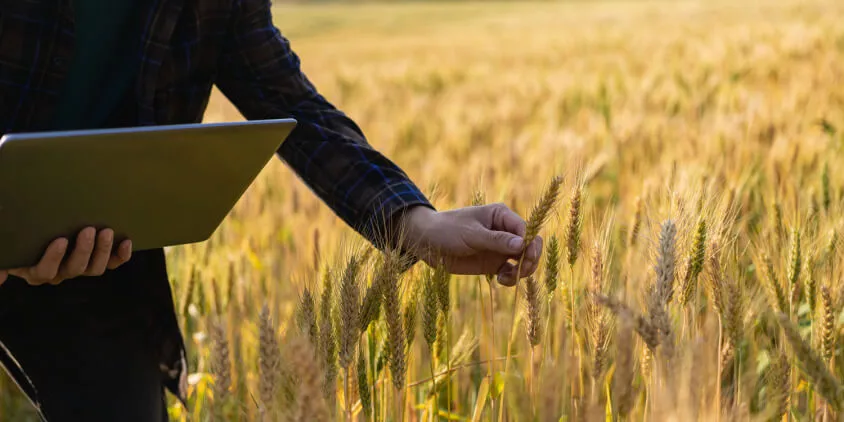
Best Agriculture Software For Field Management
Modern growers have access to a wide selection of top rated digital solutions. These best smart farming tools differ in the range of services they render and the data they rely on. The choice is more than rich, and the wealth of information they provide may be overwhelming at times. The best option to avoid getting confused is to choose the smart farming solution that best responds to the specific needs of your enterprise.
EOSDA Crop Monitoring
EOSDA Crop Monitoring is a cloud-based agriculture software developed by EOS Data Analytics. It stands out as one of the best precision agriculture software solutions for remote field management. By collecting and interpreting data derived from satellite images, this multi-language go-to platform helps agrarians all across the globe watch their fields and make smart decisions. Thanks to the detailed insights provided by the platform, it’s a top choice for different parties related to the agro-industry, including insurance agents, NGOs (non-governmental organizations), telecommunications companies, and more.
The following top performing features are available in EOSDA Crop Monitoring for now, with more on the way:
- satellite crop health monitoring;
- pest and crop disease risk identification;
- field zoning according to crop productivity;
- VRA maps based on vegetation indices;
- crop maps;
- plant growth stages;
- fertilizer application calculator;
- soil moisture, plant water stress and irrigation needs;
- weather data (including precipitation)
- detection of cold and heat stress in plants;
- customizable report and alerts;
- comparison of real-time vs. historical data on vegetation and weather;
- crop rotation data;
- fieldwork scheduling.
This top smart farming solution allows for the simple export of data in various formats for use in farm machinery as well as easy access to data via an API. The platform is available from any computer or mobile device, and its specially designed mobile app for scouting can be used even when there is no internet connection.
To fit your needs, EOSDA offers a range of the best pricing options that are charged depending on the area being analyzed, along with many add-ons and custom solutions, all built on the know-how of its top R&D (research and development) team and over 50 dedicated scientists.
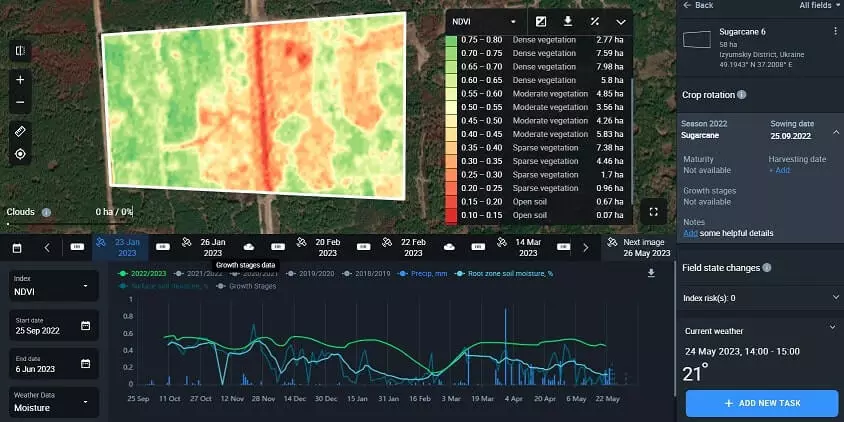

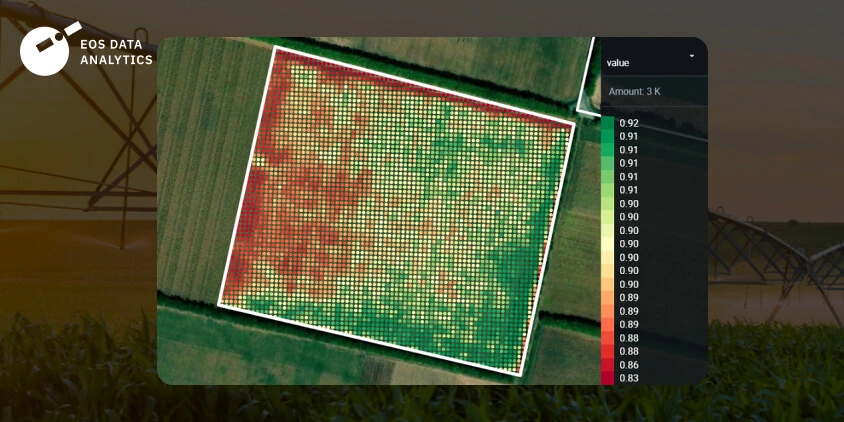
Trimble
This US agribusiness app suggests smart farming solutions for various participants, from growers to retailers and food companies. The farming app is available in mobile, desktop, and cloud versions, making it one of the top picks for farms of any size. It offers a subscription and a free trial period.
Trimble’s best known features include:
- quality weather insights;
- field and seed monitoring (quality and distribution);
- farm fleet management via in-cab displays;
- variable applications (seeds and fertilizer combinations);
- field record-keeping and access to historical data;
- price tracking;
- profit mapping.
Trimble earns its place among the top solutions by turning data into decisions.
Climate FieldView
Climate FieldView is one of the top platforms for visualizing and unifying your field data. This farming solution is simple to install and allows for keeping all data in one place. As the name suggests, this app shows weather data and rainfall in particular. Yet this is not its only advantage. Its essential features provide:
- data connectivity via the in-cab hardware FieldView Drive with the possibility to get historical and real-time field maps to your account;
- data visualization with real-time digital maps on seeding, spraying, and harvesting;
- crop performance evaluation and analysis, including comparing field and soil maps, spray applications, and determining the best crop for the next season;
- field health and vegetation monitoring with satellite imagery or scouting to identify critical issues early;
- input optimization with variable-rate seeding and customized fertilization prescriptions;
- access to the farming app from a PC or a mobile device, with a free trial available.
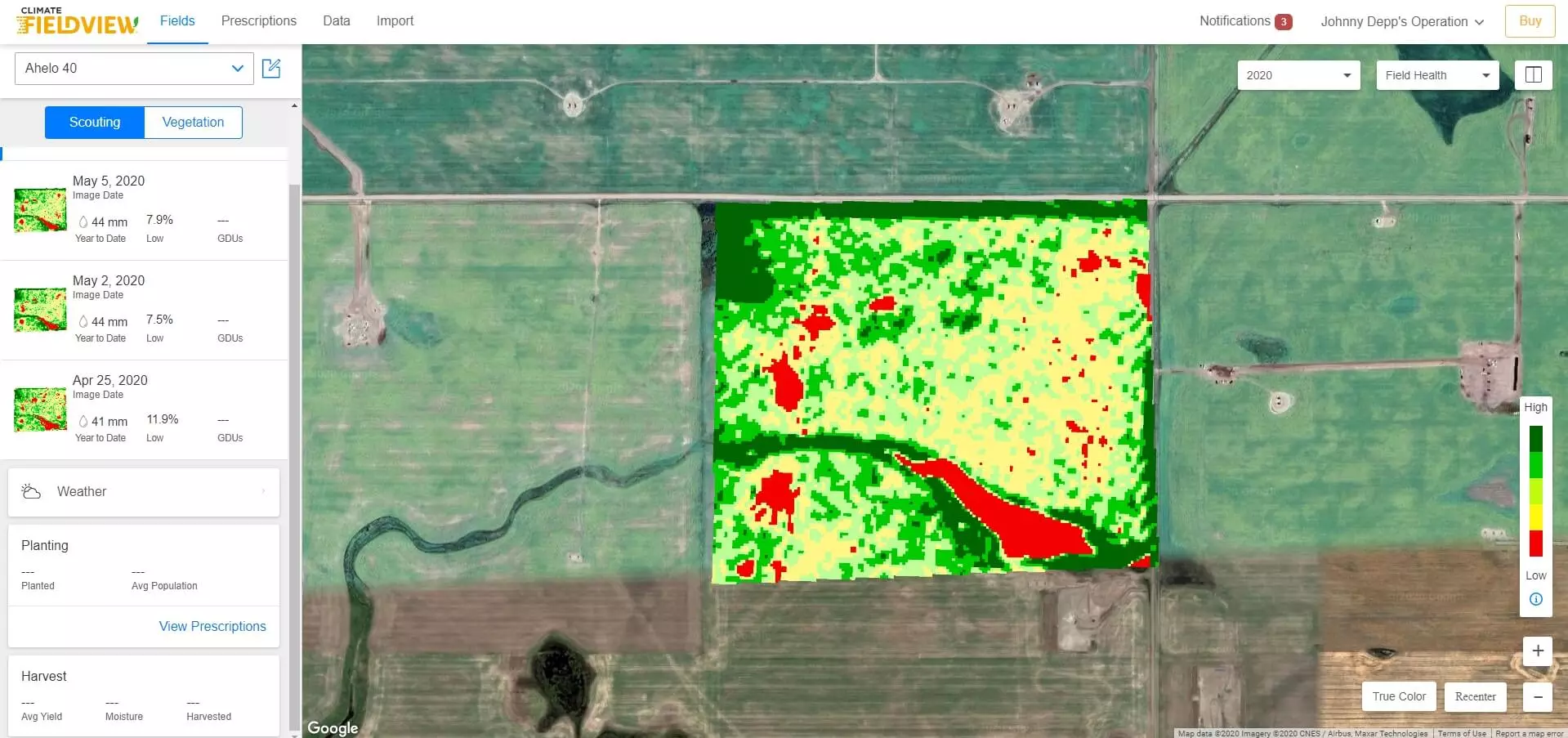
FarmCommand
Farmers Edge is a Canadian company founded in 2005 with a focus on top precision farming. The company’s program, FarmCommand, interprets data from private satellites and hardware installed in the fields. Their on-farm equipment includes:
- weather stations;
- soil moisture sensors, soil probes with further laboratory analysis;
- on-farm telematics for equipment monitoring and remote machinery operations.
The platform integrates all retrieved data in one place, generating comprehensive farm management prescriptions. With multi-language support, FarmCommand remains a top pick for diverse farming regions.
Agrivi
This UK platform for farm management is recognized among the best, helping agrarians run vertically integrated enterprises in 150 countries. While it’s packed with top tier features, it enables product quality control, tracks field activities, and checks compliance with standards. Agrivi offers farm management utilities suitable for small, medium, or large businesses.
The platform’s top capabilities assist in major field operations:
- soil cultivation,
- planting,
- pest detection,
- spraying,
- fertilization,
- harvesting.
The farm management app produces financial reports, sales management reports, risk alerts, and due payment reminders. It also includes top features of an agribusiness record-keeping app.

Agrain
The platform was designated in 2004 for various agribusiness stakeholders. It targets farmers, product providers, retailers, food processing companies, and professional agronomic advisors.
This is one of the top agriculture software programs that primarily focuses on precision and sustainability, analytics, agronomic planning, and food safety compliance. It deals with soil testing, field and yield mapping, crop protection, and fertilizing through a variable-rate approach. The collected data can be easily shared between the involved parties.
Cropwise Operations (ex.Cropio)
By remotely monitoring agricultural land, users of the Cropwise Operations satellite-based agriculture crop analysis software are equipped to organize and execute farming activities in the best way. It not only keeps track of crops and fields and informs on their current condition in near real time, but also analyzes the market for cultivated products. Language options for the farming program include German, English, French, Portuguese, and Spanish.
Granular
The company is oriented toward farmers in the USA, Canada, and Australia. This top farming tool gives satellite-based field insights. It analyzes crop health, inventory utilization, soil fertility, and composition. You can access the app either on your desktop computer or on your Android or iOS device.
The program enables task assignments for farm workers. It provides top technical and agronomical support for strong farm-running decisions. Granular farm software also offers predictive models for increasing profitability. One of the best features is the multi-location feature that allows viewing diverse terrains in one window. While it’s great that so much information is available on the platform, this abundance makes it challenging for new users to get up and running and complicates navigating the site, even for seasoned users.

BushelFarm
The history of BushelFarm (formerly FarmLogs) begins in 2011. This farm management program offers several pricing plans that can be customized with add-ons. It has a desktop version as well as Android and iOS versions.
Being a top utility for independent farmers, the app claims to make the farm-running process as hassle-free as possible. It renders the following services:
- rainfall/heat history;
- field monitoring with satellite images or scouting;
- soil mapping;
- plant growth and maturing stages;
- fluctuation of market prices in a particular locality with a ZIP code;
- profit and loss;
- operation manager with reports on activities;
- email notifications.
Farmbite
Farmbrite is an all-inclusive farming app for keeping track of your farm’s records and managing livestock, one of the best in its category. Due to its top focus on efficient farm management, it can facilitate agricultural businesses in areas such as task planning and allocation, livestock monitoring, crop production tracking, pattern detection, and streamlined accounting. The farming app will work best for market gardeners, grain and soy farmers, and livestock producers. This platform, however, is not a silver bullet; rather, it is a blank structure for you to fill in with your own information and customize to best fit your farming needs.
Smart Farming App Types And Their Uses
Modern farming apps and programs are grouped according to the scope of tasks they fulfill best and their primary practical applications. Using state-of-the-art technology like satellites, drones, IoT (Internet of Things) sensors, and many more, this program can be helpful for a wide variety of purposes, such as crop monitoring, keeping track of farm finances, and dispatching scouts to inspect the field area. The top categories of smart agri tools are outlined below.
Farm Management Apps
Current farm management software systems are designed to help farms keep costs down, stay in line with regulations, and produce safe, high-quality products . These best farm management platforms allow for the centralization, administration, and streamlining of virtually all activities and operations on a farm. This way, agricultural management software boosts farm efficiency across the board, from worker output to crop yields to bottom-line profits. This program entails significant clusters:
- Crop management suggests plant growth monitoring and the prediction of yields.
- Management and finances entail general farm management issues, including farm supervision, inventory maintenance, financial reports, control and guidance of workers, etc.
- Agriculture ERP (enterprise resource planning) software allows for the collection of information regarding crop conditions, personnel work, and farming activities for further analysis and planning.
- Top field monitoring and sensors cover a vast scope of essential features, including plant growth, pest control and weed management, fertilizing and irrigation, weather, and soil conditions.
Agriculture Accounting Software
Many top accounting programs are adaptable and may be used in different contexts, but some work far better for farmers’ specific demands. The best farm accounting app will be flexible enough to handle both common accounting tasks like invoicing and monitoring bills and specialized tasks such as setting up cost centers to break down profit and loss by farm divisions. The options range from more complex with advanced features like agricultural inventory and noncurrent-asset accounting to straightforward with simple functions like keeping records of income and expenses and paying bills.
Precision Agriculture Software
With the use of precision agriculture and predictive analytics, farmers can optimize input costs and increase field performance. The best precision agriculture software leverages digital data to pinpoint the most crucial regions for chemical application, ensuring they receive the exact treatment needed for maximum crop health and increased yield. Type of soil, topography, weather conditions, plant growth stage, and yield statistics are just some of the factors that these agribusiness apps take into account while managing crops with a focus on financial viability, sustainable farming practices, and environmental protection.
The cost of top precision farming tools was previously out of reach for all but the largest agribusinesses. Affordable pricing has made these apps accessible to even small farms. For this reason, they have been gaining popularity over the past few years.
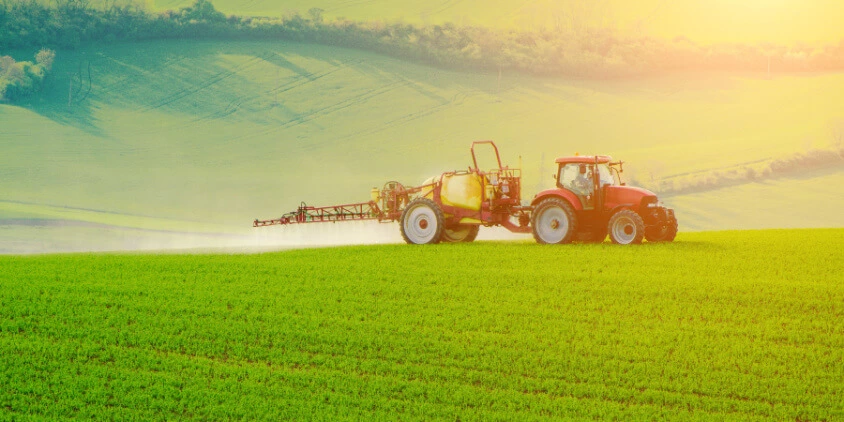
Agriculture Mapping Software
Mapping software used in agriculture can greatly benefit from data gathered by drones and satellites. Because of the spatial nature of farming, GIS mapping has proven to be an invaluable tool in assisting farmers in making informed decisions about where and when to plant, irrigate, fertilize, and harvest. The best agricultural mapping software improves the scouting process, helps identify areas of possible plant stress, and aid in the early detection of problems. By using top agriculture remote sensing applications, it is possible to predict the health and productivity of a field well in advance of any visible changes in the plants . Complete awareness of your land’s features and the development of accurate field maps using the appropriate agritech apps are essential for maximizing crop yields and ensuring each plot remains in good condition throughout time.
Farming Drone Apps
Top smart farming apps designed specifically for use with drones and other unmanned aerial vehicles (UAVs) are now among the best methods for streamlining tasks like crop monitoring, tracking livestock, and collecting and interpreting any data from the fields. With the actionable insights provided by UAV agriculture software, farmers can optimize all inputs and minimize expenses in crop production. On top of that, these systems are not only useful in agronomy but also in mining, building, mapping, surveillance, and other scientific and academic projects.
To be labeled as such, top agriculture drone apps must meet the following requirements:
- automated UAV flight planning and status updates;
- assistance in the organization and transparency of farm monitoring;
- targeted data analysis for the agricultural sector.
Keep in mind that drones cover much smaller areas at once than satellites do, which is an important consideration when comparing applications that use drone vs. satellite data.
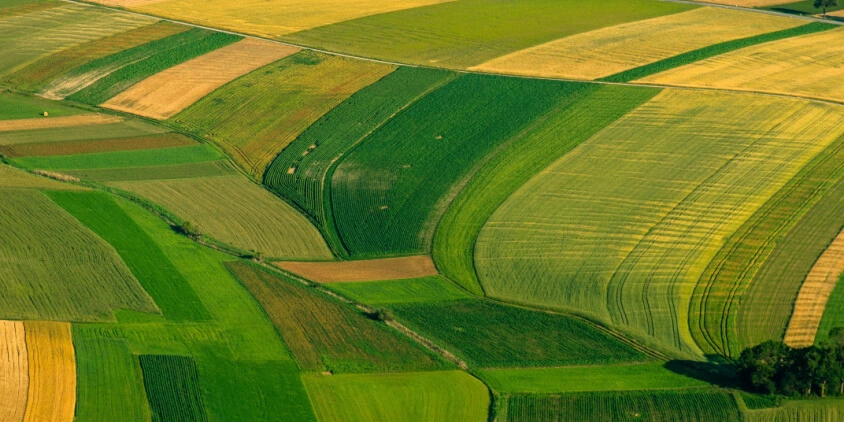
Tips To Navigate In The Ocean Of Agronomic Programs
Farming is a business, and a good one demands top performance with best tools. However, a discerning farmer also seeks ways with low inputs, moderate resource consumption, and the least harm to nature. An appropriate agronomic tool is what makes a huge difference in accuracy and sustainability on the farm.
Before settling on a specific farming app that fits their needs and objectives, large agricultural companies should consider a number of aspects. If you need some top tips and pointers as you make a choice, here they are:
- Data management and analysis. The best platforms can swiftly and accurately process and analyze large volumes of data, such as field maps, weather data, and scouting reports, to provide you with evidence-based advice .
- Historical data. Look for a top agronomic app that can effectively store and analyze past data (including historical agriculture satellite images), so you can optimize your farming methods based on past experiences rather than guesswork.
- Scalability. Choose a top rated farming app that is flexible enough to accommodate different farm sizes and can scale along with your business as it grows.
- Integration. Evaluate whether the program can seamlessly integrate with your current infrastructure, including your farm machines and weather stations.
- Onboarding and support. To ensure a smooth implementation process, you should look for top providers who guarantee detailed documentation, online tutorials, training sessions, and responsive customer support.
And here’s one extra tip: search for the best farming tool from companies that put money into R&D and keep up with technological advances in the agricultural sector. EOSDA provides a software solution for agriculture that is already advanced, extensible, user-friendly, and easily integrated, with plans to add even more practical features and enhancements in the future.
Contact our sales team at sales@eosda.com to learn more about the EOSDA Crop Monitoring possibilities. Don’t hesitate to implement the best data-driven and efficient solutions into your daily farming practices.
About the author:
Petro Kogut has a PhD in Physics and Mathematics and is the author of multiple scientific publications. He is the Soros Associated Professor as well as the head of the department of differential equations in the Oles Honchar Dnipro National University and has received a number of grants, prizes, honorary decorations, medals, and other awards. Prof. Dr. Petro Kogut is a science advisor for EOSDA.
Recent articles
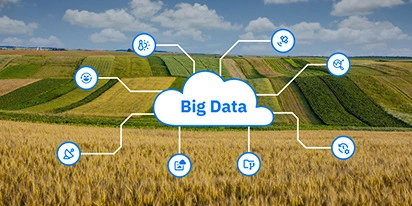
Big Data In Agriculture Backed By Satellites & Sensors
The days when big data in agriculture was only for tech-savvy large farms are over. Today, easy-to-use platforms make it accessible to any farmer ready to work more efficiently.
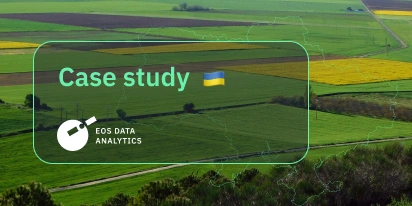
Analyzing Seized Arable Land In Ukraine For PEJ
EOSDA conducted a field-by-field satellite analysis to help Project Expedite Justice expose how Russian occupying authorities continued to farm seized land in Ukraine from 2020 to 2024.
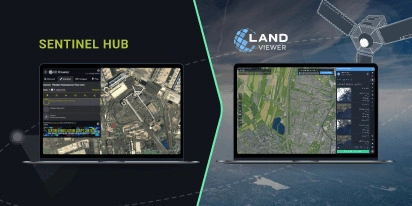
Transition Guide From Sentinel Hub EO Browser To EOSDA LandViewer
Need an EO Browser alternative that’s just as familiar but more flexible? EOSDA LandViewer offers free recent imagery, a vast satellite data archive, and advanced analytical tools.